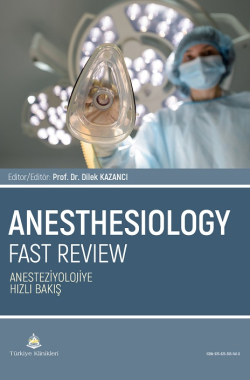ANESTHESIA MACHINES AND PRINCIPLES
Ekin Güran
Etlik City Hospital, Department of Anesthesiology and Reanimation, Ankara, Türkiye
Güran E. Anesthesia Machines and Principles. In: Kazancı D, editor. Anesthesiology Fast Review. 1st ed. Ankara: Türkiye Klinikleri; 2025. p.535-542.
ABSTRACT
- Anesthesia machines evolved a great deal from Boyle’s trolley at the beginning of the 20th century to today’s computer-assisted anesthesia workstations utilizing enhanced safety and monitoring features.
- They deliver a controlled mixture of medical gases and inhalational anesthetics while continuously monitoring the patient’s vital signs and respiratory mechanics.
- The machine operates with high-, intermediate-, and low-pressure systems, ensuring the safe gas flow with adequate pressures before delivering it to the patient.
- Medical gases are supplied from backup cylinders or the hospital’s central pipeline systems via color-coded pipelines. Improper gas connections are prevented by additional safety features.
- Flowmeters regulate the gas flow into the machine, while vaporizers dispense volatile anesthetics.
- Ventilators and breathing circuits are part of the gas delivery system, which regulates oxygenation and carbon dioxide removal while delivering anesthetic gases.
- Modern anesthesia machines have several ventilation modes, including mandatory, assisted spontaneous, and synchronized ventilation, which provides flexibility for the different needs of the patient.
- Scavenging systems are used to remove anesthetic waste, to reduce pollution.
- Monitoring electrocardiography, blood pressure, oxygen saturation, end-tidal CO2, and anesthetic gas levels throughout the surgery are essential to ensure safety.
- Regular machine checks, including the automated self-tests, the two-bag test, and the tug test, are required to ensure proper operation and avoid equipment-related anesthetic risks.
Keywords: Anesthesia; Respiratory mechanics; Mechanical ventilators
×
Kaynak Göster
Referanslar
- López-Valverde A, Montero J, Albaladejo A, Gómez de Diego R. The Discovery of Surgical Anesthesia:Discrepancies Regarding Its Authorship. Journal of Dental Research. 2011;90(1):31-4. [Crossref] [PubMed]
- Thompson P, Wilkinson D. Development of anaesthetic machines. British Journal of Anaesthesia. 1985;57(7):640-8. [Crossref] [PubMed]
- Watt O. The evolution of the Boyle apparatus, 1917-67. Anaesthesia. 1968;23(1):103-18. [Crossref]
- Sinclair CM, Thadsad MK, Barker I. Modern anaesthetic machines. Continuing Education in Anaesthesia, Critical Care & Pain. 2006;6(2):75-8. [Crossref]
- RENDELL-BAKER L. Standards for anesthetic and ventilatory equipment. International Anesthesiology Clinics. 1982;20(3):171-204. [Crossref] [PubMed]
- Schreiber P. Anaesthesia equipment: performance, classification and safety: Springer Science & Business Media; 2013. [Link]
- Briggs G, Maycock J. The anaesthetic machine. Anaesthesia & Intensive Care Medicine. 2016;17(3):115-9. [Crossref]
- Dorsch JA. Understanding anesthesia equipment: Lippincott Williams & Wilkins; 2012. [Link]
- Tankó B, Molnár L, Fülesdi B, Molnár C. Occupational hazards of halogenated volatile anesthetics and their prevention: review of the literature. J Anesth Clin Res. 2014;5(7):1-7. [Crossref]
- Varughese S, Ahmed R. Environmental and occupational considerations of anesthesia: a narrative review and update. Anesthesia & Analgesia. 2021;133(4):826-35. [Crossref] [PubMed] [PMC]
- Vollmer MK, Rhee TS, Rigby M, Hofstetter D, Hill M, Schoenenberger F, et al. Modern inhalation anesthetics: Potent greenhouse gases in the global atmosphere. Geophysical Research Letters. 2015;42(5):1606-11. [Crossref]
- Anesthesiologists ASo. Standards for Basic Anesthetic Monitoring [updated December 13, 2020. Available from: [Link]
- Hartle A, Anderson E, Bythell V, Gemmell L, Jones H, McIvor D, et al. Checking anaesthetic equipment 2012: association of anaesthetists of Great Britain and Ireland. Anaesthesia. 2012;67(6):660-8. [Crossref] [PubMed]

